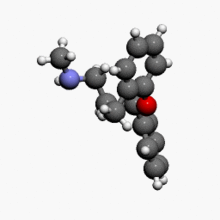Atomoksetin
Atomoksetin je organsko jedinjenje, koje sadrži 17 atoma ugljenika i ima molekulsku masu od 255,355 Da.[1][2][3][4][5][6][7][8][9][10][11]
 | |
 | |
| Klinički podaci | |
|---|---|
| Drugs.com | Monografija |
| Način primene | Oralno |
| Farmakokinetički podaci | |
| Poluvreme eliminacije | 5 h |
| Identifikatori | |
| CAS broj | 82248-59-7 |
| ATC kod | N06BA09 (WHO) |
| PubChem | CID 54841 |
| DrugBank | DB00289 |
| ChemSpider | 49516 |
| ChEBI | CHEBI:127342 |
| ChEMBL | CHEMBL641 |
| Hemijski podaci | |
| Formula | C17H21NO |
| Molarna masa | 255,355 |
| |
| |
Osobine
уреди| Osobina | Vrednost |
|---|---|
| Broj akceptora vodonika | 2 |
| Broj donora vodonika | 1 |
| Broj rotacionih veza | 6 |
| Particioni koeficijent[12] (ALogP) | 3,6 |
| Rastvorljivost[13] (logS, log(mol/L)) | -5,1 |
| Polarna površina[14] (PSA, Å2) | 21,3 |
Reference
уреди- ^ Spencer TJ, Faraone SV, Michelson D, Adler LA, Reimherr FW, Glatt SJ, Biederman J: Atomoxetine and adult attention-deficit/hyperactivity disorder: the effects of comorbidity. J Clin Psychiatry. 2006 Mar;67(3):415-20. PMID 16649828
- ^ Pilhatsch MK, Burghardt R, Wandinger KP, Bauer M, Adli M: Augmentation with atomoxetine in treatment-resistant depression with psychotic features. A case report. Pharmacopsychiatry. 2006 Mar;39(2):79-80. PMID 16555170
- ^ Carpenter LL, Milosavljevic N, Schecter JM, Tyrka AR, Price LH: Augmentation with open-label atomoxetine for partial or nonresponse to antidepressants. J Clin Psychiatry. 2005 Oct;66(10):1234-8. PMID 16259536
- ^ Kratochvil CJ, Newcorn JH, Arnold LE, Duesenberg D, Emslie GJ, Quintana H, Sarkis EH, Wagner KD, Gao H, Michelson D, Biederman J: Atomoxetine alone or combined with fluoxetine for treating ADHD with comorbid depressive or anxiety symptoms. J Am Acad Child Adolesc Psychiatry. 2005 Sep;44(9):915-24. PMID 16113620
- ^ McElroy SL, Guerdjikova A, Kotwal R, Welge JA, Nelson EB, Lake KA, Keck PE Jr, Hudson JI: Atomoxetine in the treatment of binge-eating disorder: a randomized placebo-controlled trial. J Clin Psychiatry. 2007 Mar;68(3):390-8. PMID 17388708
- ^ Purper-Ouakil D, Fourneret P, Wohl M, Reneric JP: [Atomoxetine: a new treatment for Attention Deficit/Hyperactivity Disorder (ADHD) in children and adolescents] Encephale. 2005 May-Jun;31(3):337-48. PMID 16142049
- ^ Simpson D, Plosker GL: Atomoxetine: a review of its use in adults with attention deficit hyperactivity disorder. Drugs. 2004;64(2):205-22. PMID 14717619
- ^ Montoya A, Hervas A, Cardo E, Artigas J, Mardomingo MJ, Alda JA, Gastaminza X, Garcia-Polavieja MJ, Gilaberte I, Escobar R: Evaluation of atomoxetine for first-line treatment of newly diagnosed, treatment-naive children and adolescents with attention deficit/hyperactivity disorder. Curr Med Res Opin. 2009 Nov;25(11):2745-54. PMID 19785510
- ^ Gaillez C, Sorbara F, Perrin E: [Atomoxetine (Strattera), an alternative in the treatment of attention-deficit/hyperactivity disorder (ADHD) in children] Encephale. 2007 Sep;33(4 Pt 1):621-8. PMID 18033153
- ^ Knox C, Law V, Jewison T, Liu P, Ly S, Frolkis A, Pon A, Banco K, Mak C, Neveu V, Djoumbou Y, Eisner R, Guo AC, Wishart DS (2011). „DrugBank 3.0: a comprehensive resource for omics research on drugs”. Nucleic Acids Res. 39 (Database issue): D1035—41. PMC 3013709 . PMID 21059682. doi:10.1093/nar/gkq1126.
- ^ David S. Wishart; Craig Knox; An Chi Guo; Dean Cheng; Savita Shrivastava; Dan Tzur; Bijaya Gautam; Murtaza Hassanali (2008). „DrugBank: a knowledgebase for drugs, drug actions and drug targets”. Nucleic acids research. 36 (Database issue): D901—6. PMC 2238889 . PMID 18048412. doi:10.1093/nar/gkm958.
- ^ Ghose, A.K.; Viswanadhan V.N. & Wendoloski, J.J. (1998). „Prediction of Hydrophobic (Lipophilic) Properties of Small Organic Molecules Using Fragment Methods: An Analysis of AlogP and CLogP Methods”. J. Phys. Chem. A. 102: 3762—3772. doi:10.1021/jp980230o.
- ^ Tetko IV, Tanchuk VY, Kasheva TN, Villa AE (2001). „Estimation of Aqueous Solubility of Chemical Compounds Using E-State Indices”. Chem Inf. Comput. Sci. 41: 1488—1493. PMID 11749573. doi:10.1021/ci000392t.
- ^ Ertl P.; Rohde B.; Selzer P. (2000). „Fast calculation of molecular polar surface area as a sum of fragment based contributions and its application to the prediction of drug transport properties”. J. Med. Chem. 43: 3714—3717. PMID 11020286. doi:10.1021/jm000942e.
Literatura
уреди- Hardman JG, Limbird LE, Gilman AG (2001). Goodman & Gilman's The Pharmacological Basis of Therapeutics (10. изд.). New York: McGraw-Hill. ISBN 0071354697. doi:10.1036/0071422803.
- Thomas L. Lemke; David A. Williams, ур. (2007). Foye's Principles of Medicinal Chemistry (6. изд.). Baltimore: Lippincott Willams & Wilkins. ISBN 0781768799.
Spoljašnje veze
уреди
| Molimo Vas, obratite pažnju na važno upozorenje u vezi sa temama iz oblasti medicine (zdravlja). |